Kaeltyk on Mandelbulber and 3D fractals
by Alexandre ProkoudineConversation with 3D fractals artist Eric 'Kaeltyk' Prevost about generative art and its perspectives, 2D and 3D fractals and, of course, Mandelbulber
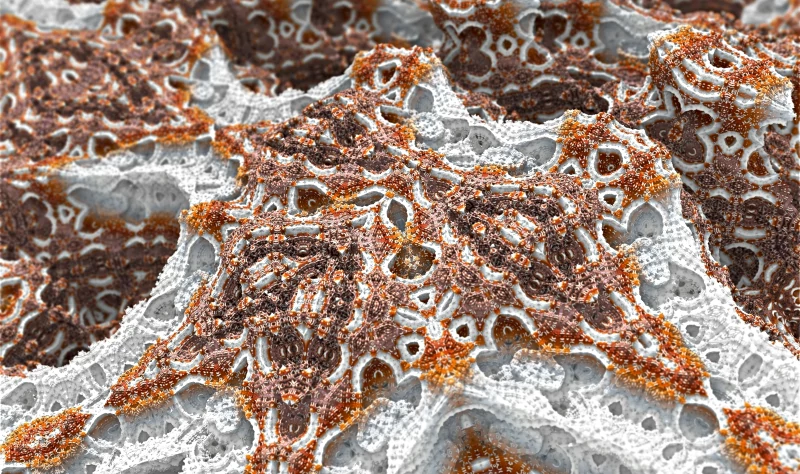
I’ve been meaning to talk to Eric Prevost aka Kaeltyk for a while, because I had been following (and admiring) his work even before he discovered Mandelbulber, a free 3D fractals explorer by Krzysztof Marczak.
Personally I feel that generative art is a bit underloved and underappreciated which is yet another reason for this short interview.
Eric, judging by some of your comments on DeviantArt you are in CG professionally. Is that so? Is fractal art a little bit more than just hobby for you?
I have some rather fulfilled past on the computer graphics side. The first thing I made with computers were some procedural carpets in 40×40 pixels on Apple ][. This was my real first step into the programming and graphic world. Fractals came to me with the first Mandelbrot/Julia representations on Atari 520st, and later I started to use POV-Ray to create images.
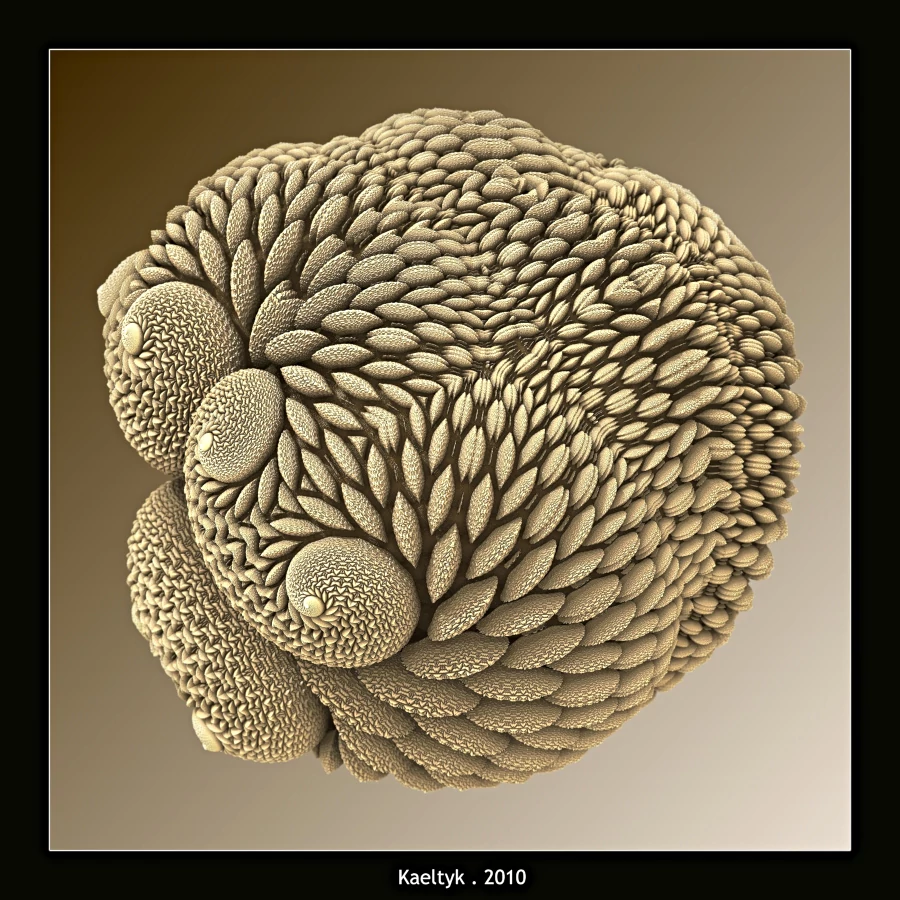
Then I made some CAD/CAM engineer studies that led me to find a work as real-time 3D modeler in a video games company after showing a POV-Ray demonstration book, so we can tell I’ve a nice knowledge of the many forms of CGs. I’m currently a gameplay programmer — a job not related to graphics, but I still follow a lot of graphic software/demos that revolve around graphics and, of course, fractals. Internet is a source of many wonderful graphic discoveries and explorations.
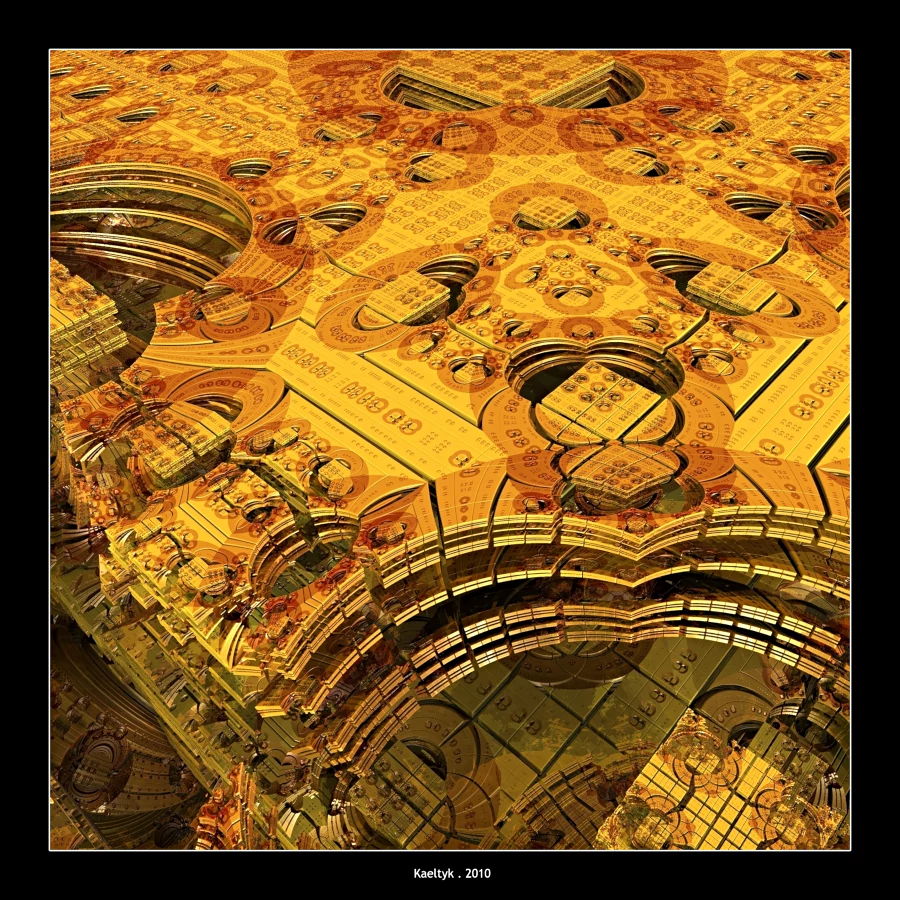
Even if there was some lengthy periods when I did not touch software, I’m still very fond of their architecture and hidden mysteries. It’s a hobby, and maybe the only one I would keep, if I had to choose!
Fractals and generative art per se are often considered to be experimental art. Do you think it’s fair? Do they deserve much more exposure?
For me fractals are experimental art, and it was once again shown with the quite new discovery of 3D fractals forms like mandelbulbs or boxes or other 3D recursives. It’s only because some people think like “what happens, if I try this [insert mathematical formula/process]” that the fractals domain expands, and thanks to people who like to fully explore a single formula some specific “places” are discovered. Of course, once someone shares some specific formula, other fractalists look around this, and we start to see some new style families, but to me the interest of fractals is to move around and try new things.
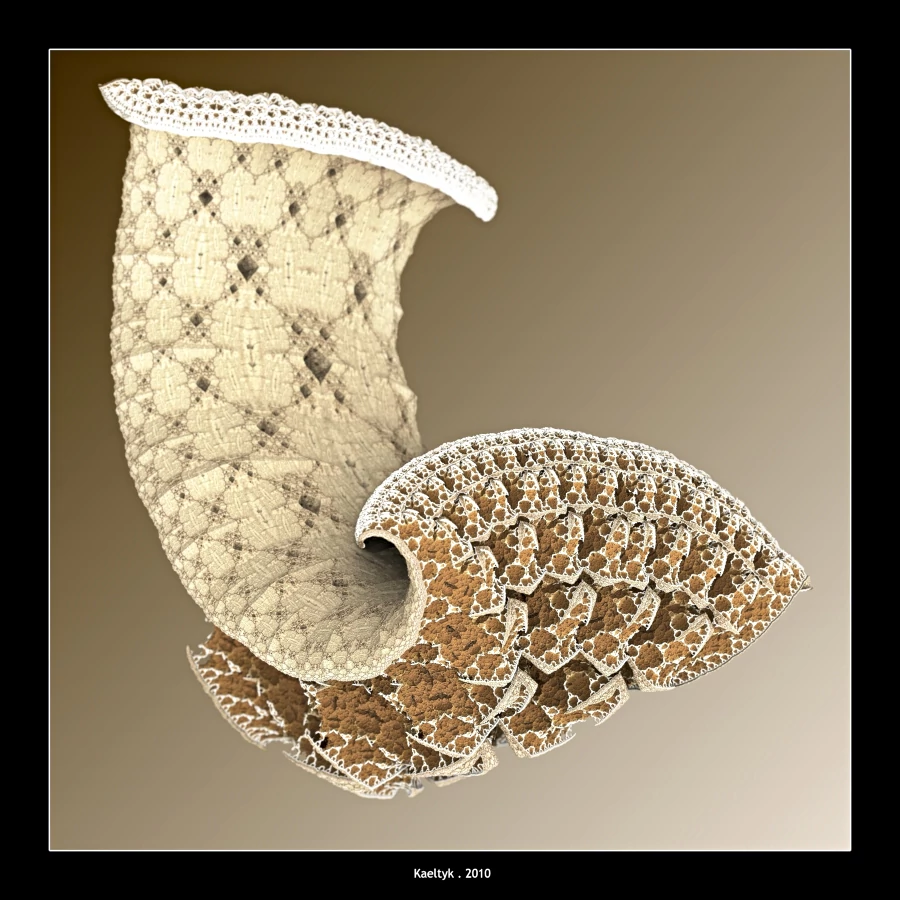
That’s a very personal vision of fractals, as I’m an “explorer”. If you consider some artists that are more focused on some specific styles, then it’s a lot more about tools and knowledge than experimentation.
And I don’t think that fractal art lacks exposure. Some well-known fractal artists are exposed around the world, and if I’m not, maybe that’s just because I don’t take enough time to show my work around as it is a hobby — and I do have others (like playing bass guitar, calligraphy, …). Maybe if someone asked me to have my works exhibited somewhere, then I’d think about myself as an artist. I think some other great fractal artists could be exposed too — but that’s a personal choice to invest time and energy for this, as even for them it’s just a hobby.
When you start playing with a formula or a combination of formulas (the Hybrid formula in Mandelbulber), do you usually already have something in mind, so you just iteratively refine it? Or is it a pure improvisation? As far as I can tell you go far beyond the default shapes and experiment a lot with translations etc.
I consider myself as a “button pusher” — the kind of person that many fractal artists despise, but we can call this improvisation to look like more interesting :) Or “exploration” maybe.

To refine a bit more my way of working and compare this to some real world let’s say that I’m like a photographer who walks from some place he knows and tries to move around, trying to follow the paths he hasn’t yet visited already, taking shots around. Some of his shots will be interesting, some others — not. But these could be some nice places to start a new exploration. So I like trying to test all these buttons in the software and this make me find things, learn their purpose and finally master the software.
Some people like to rely on what they already know; I like to explore what I don’t know. Of course I come back to some “shots” I made earlier to refine them, when I feel something can be improved to a level of quality high enough, and I also like to challenge myself from time to time to create something relying on limited/fixed resources/formulas.
That’s probably why looking at my own gallery I don’t find much coherency between all the works like some artists do have.
I’ve noticed that you do very fine-tuned coloring of fractal bodies. How do you do it? Do you load palettes from images?
Yes, I try using my own palettes most of the time, even if I have some software-provided favorites that I know well and use often. And my CG past (POV-Ray, OpenGL Real Time 3D) made me a lot more sensitive to how lighting/coloring works, so I often understand how to use all the lighting parameters and possibilities in each software to achieve desired results.
Fractal graphics software tends to be rather complicated and usually exposes a lot of math (Mandelbulber for sure). Do you think the learning curve is too steep? What advice would you give to people who are interested, but probably get discouraged
Learning to create fractals is a long, long way! By “create” I mean that you can start from scratch and achieve something without relying on others, and this excludes tweaking shared parameters that is a common practice.
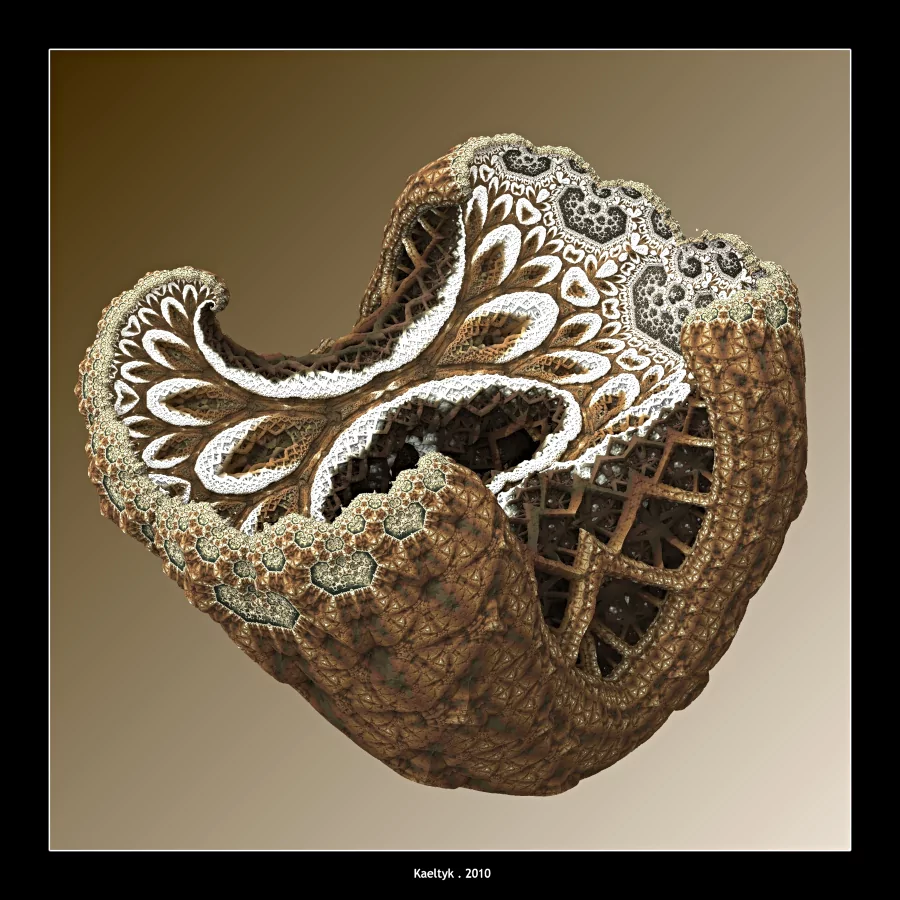
Personally I took almost 6 months generating random flames in Apophysis and trying to refine them, specifying the transforms, mutating them… pushing every buttons until I knew how they work until trying to create my own “flames” from scratch.
Today I lost a bit of my Apophysis knowledge with all the new transformations, and I estimate that I still don’t know more than 5% of the UltraFractal formulas, 50% of XenoDream capabilities and still have to learn some fractal software I haven’t even touched (like M3D). Yes, that’s tough!
But you can’t cut learning everything — from mathematics to patterns to coloring to lighting — if you want to achieve something. I don’t find this steeper or longer or harder to learn than traditional art forms, but it may not be for everybody.
There are new things discovered all the time, e.g. new formulas and even new apps like Fragmentarium that use kernel languages and take generative art to a completely new level. What are the recent new things that you find most exciting?
Real-time fractal software is really exciting, and I see more of this coming — I really hope I’ll be able to navigate in real time in some fractal landscapes before I die. You said “Fragmentarium” — that’s a great example of what is going to be common soon.
What is your most desired missing feature in Mandelbulber?
I miss a way to create my own formulas. I tried to get the code and compile my own version just to do this, but with no success. I know this is no trivial feature — Fragmentarium do this but use shaders that can be compiled on-the-fly, and Apophysis with DLLs — but that would be really great.
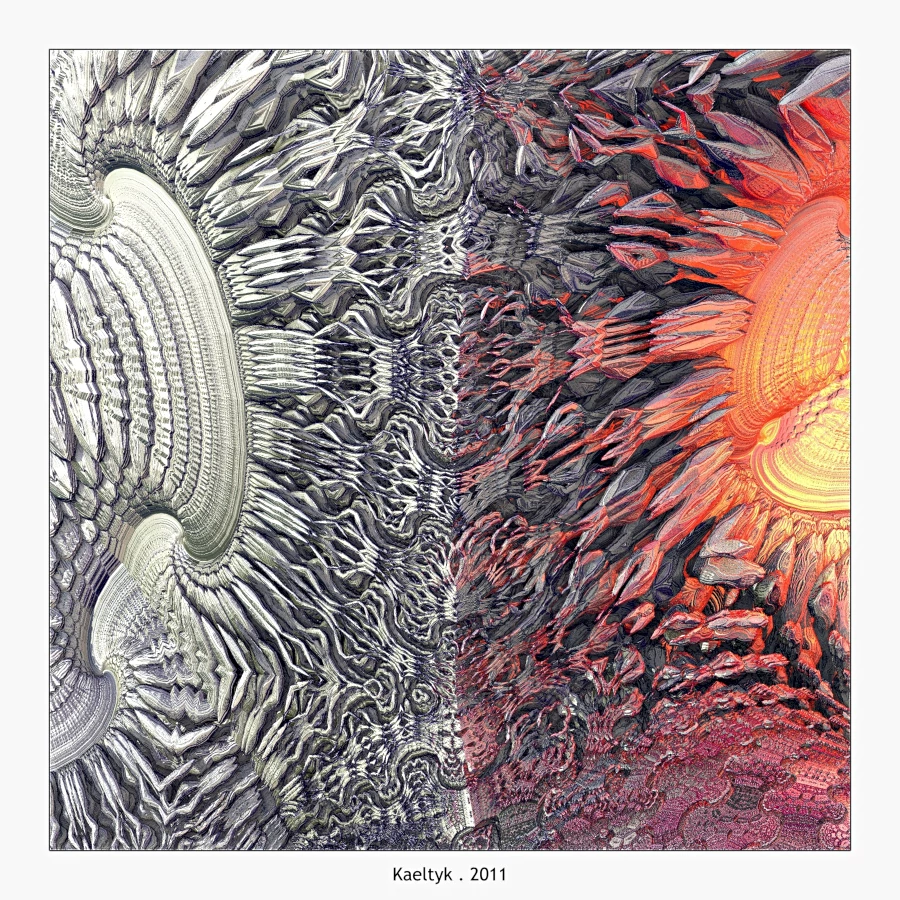
Who are the top artists whose fractal works you admire most?
Etienne Saint-Amant (DeviantArt page) is the artist that made me decide to return to fractals after almost 15 years without touching fractal software.
Janet Parke (DeviantArt page) made me decide to buy UltraFractal.
Ramon Pasternak is one of — to my taste — strongest styled artist and he really created amazing things with Apophysis and XenoDream — including animations.
Nicolas Rougeux (DeviantArt page) is one of the many artists I discovered on Deviant Art and amazed me at the first look.
Ewa Stryza is also one of the artists I’m most admiring on Deviant Art for her style — someone I can recognize the signature watching a piece before knowing it’s her’s.
Recently Astrographe made me discover fractals under a new point of view with his incredible skills at creating some pieces with fractals that are not pure fractals.
Samuel Monnier (DeviantArt page) is also a great artist that I follow with a lot of pleasure.
I’d need more than the above 7 favourites to list them all, whom are being only a part of my most inspirational artists. It’s so hard to choose just a few, so my “favourite” page on Deviant Art is a good place to check for some of my preferred artists.
Patreon subscribers get early access to my posts. If you are feeling generous, you can also make a one-time donation on BuyMeACoffee.
